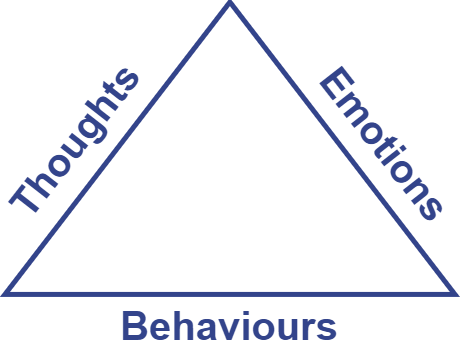What is CBT?
Evidence Based Self Help:
Cognitive-Behavioural Therapy (CBT) is a short-term, evidence-based self-help treatment for anxiety disorders, stress, depression and general well-being maintenance.
It is based on the idea that thoughts (cognitions) affect the way we feel which in turn affects how we behave/act.

It has 2 simple tenets:
1. Outside of real threats or loss it is not what happens to us that causes us to suffer but our thoughts surrounding what happens. This idea is rooted in Buddhism and Western philosophies, in particular; Stoicism.
2. Since it is not within our control to change our emotions directly, in order to change how we feel we can change how we think. We can do that by training ourselves to not use our lower order emotional brain which is our default resource when we are stressed, anxious, depressed or irritable. Instead, we can use our executive functions to deal with what is troubling us.
What we use CBT on:
The focus of CBT is on the here-and-now, the problems that come up in our day-to-day life. It helps us to look at how we interpret and evaluate what is happening around us and the effects these perceptions have on our emotional experience.
The Steps

The First Step
Finding: In CBT you start off by monitoring and recording your thoughts during situations that lead to you feeling emotional upset. These situations can be internal like an unpleasant memory or external like making a mistake during a presentation at work. This thought to emotion linking allows you to:
1. Remove your emotional interpretation of what has happened or what is happening and bring in your higher-order executive reasoning
2. Get a better understanding of how the way you think contributes to stress, depression and anxiety
3. To become better at identifying distortions/untruths in your thinking
4. To be able to view your thoughts as rough ideas about what is going on rather than as facts
5. To become a less fearful observer of your thoughts
6. To treat your thoughts as being separate to yourself and learning to consider situations from different viewpoints
The Second Step
Challenging: The simplest analogy is that you are both a detective and a lawyer and that your unhelpful thoughts are to be investigated and put on trial. You examine the evidence that does or does not support your thoughts and beliefs. In other words, you ask: Where is the proof that my negative self-talk is true? And is the situation really as hopeless as I think?
The Third Step
Replacing: After you have looked for the evidence and concluded a disputation of your thinking you then work on replacing your old unhelpful thoughts and beliefs with newer more truthful alternatives.
The Fourth Step
Reinforcing and Upkeep: This final stage is about challenging any old difficult to remove unhelpful beliefs and also to help you continuously reinforce your newer held beliefs from the third step.
Integrated Buteyko Classes
If you would like to use CBT as a way of improving and maintaining your well-being we have an integrated programme that teaches CBT together with the Buteyko method. Find out more about classes here.






